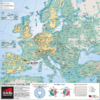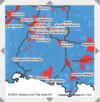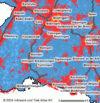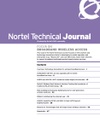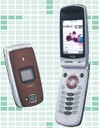
Up until now not much is known about how applications on the N80 will be able to use the built in wireless LAN capabilities. When checking the Nokia website today, I saw that the N80 manual can now be downloaded from this link. So I rushed to take a closer look to see if it sheds some light on this topic. And indeed it does!
Basically, the manual says that the use of WLAN is transparent for an application on the phone. Just like for a data connection via GPRS and UMTS, a new access point profile can be created to enter the settings of how to communicate via a WLAN network. Several profiles can be created if different WLAN networks are used, e.g. at home, at work and in public. In an application, a WLAN profile is selected from the already known list of access points that pops up when an application wants to access the network and no default access point has been configured in the application. Instead of only GPRS and UMTS connections the list can now also contain WLAN connections. Quite elegant, it’s completely transparent!
The manual also says that one access point profile can be used by several applications simultaneously. Again, this already works today for GPRS and UMTS connections when two programs such as the browser and the eMail program are used to communicate with the network at the same time.
And here comes the most important part concerning the simultaneous use of the phone in the GSM/UMTS network and WLAN. I quote from the manual on page 14: "You can use wireless LAN during a voice call or when packet data is active". That’s really great news and means that while at home, for example, the phone can be used for incoming (and outgoing) cellular calls simultaneously with an activated VoIP client (SIP, Skype…) via wireless lan.
It looks like my dream of a unified phone at home is close to becoming a reality! I can hardly wait using the Skype client on the phone to call friends while lying on the couch while not missing incoming cellular calls. Hurry up, Skype! Oh, and by the way, don’t forget to support the built in camera 🙂
SIP Update 1: Jukka left a comment that there’s already a built in SIP client in the N80. I completely missed that when browsing for the wireless LAN details in the manual. Indeed, the manual shortly describes that there’s a new menu where to enter the settings for the SIP client and that SIP addresses can now be part of a phone book entry. Would be interesting what can be configured but the manual doesn’t say. So Skype’s got another reason for hurrying up, the competition is already there!
SIP Update 2: The topic keeps developing: Too bad I don’t have an N80 yet so I have to rely on the sparse technical information in the manual. After some more digging I found out that the included SIP client seems to be closely tied into the standard voice call feature. The SIP functionality can be used during a standard voice call to establish a video sharing session via SIP in a packet bearer. While the feature is quite nice it’s not yet what I need to call someboday via VoIP over the WLAN functionality while being at home.
SIP Update 3: A reader has noticed that Nokia is about to release a major software update for the N80 called the N80i, or Internet Edition, whith some additional VoIP capabilities: From the press release: "The VoIP framework (based on the SIP protocol) is integrated into the
Nokia user interface, and the Nokia N80 Internet Edition is allows for
downloading compatible third party internet call applications.". One step closer but we still need a 3rd party client.
![]()
